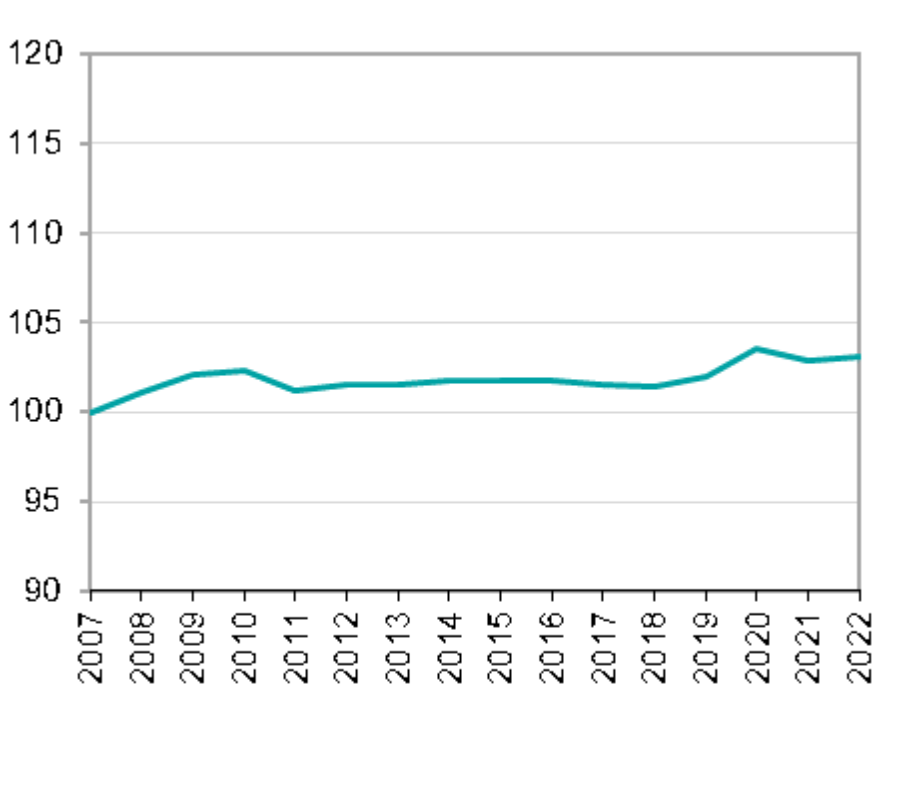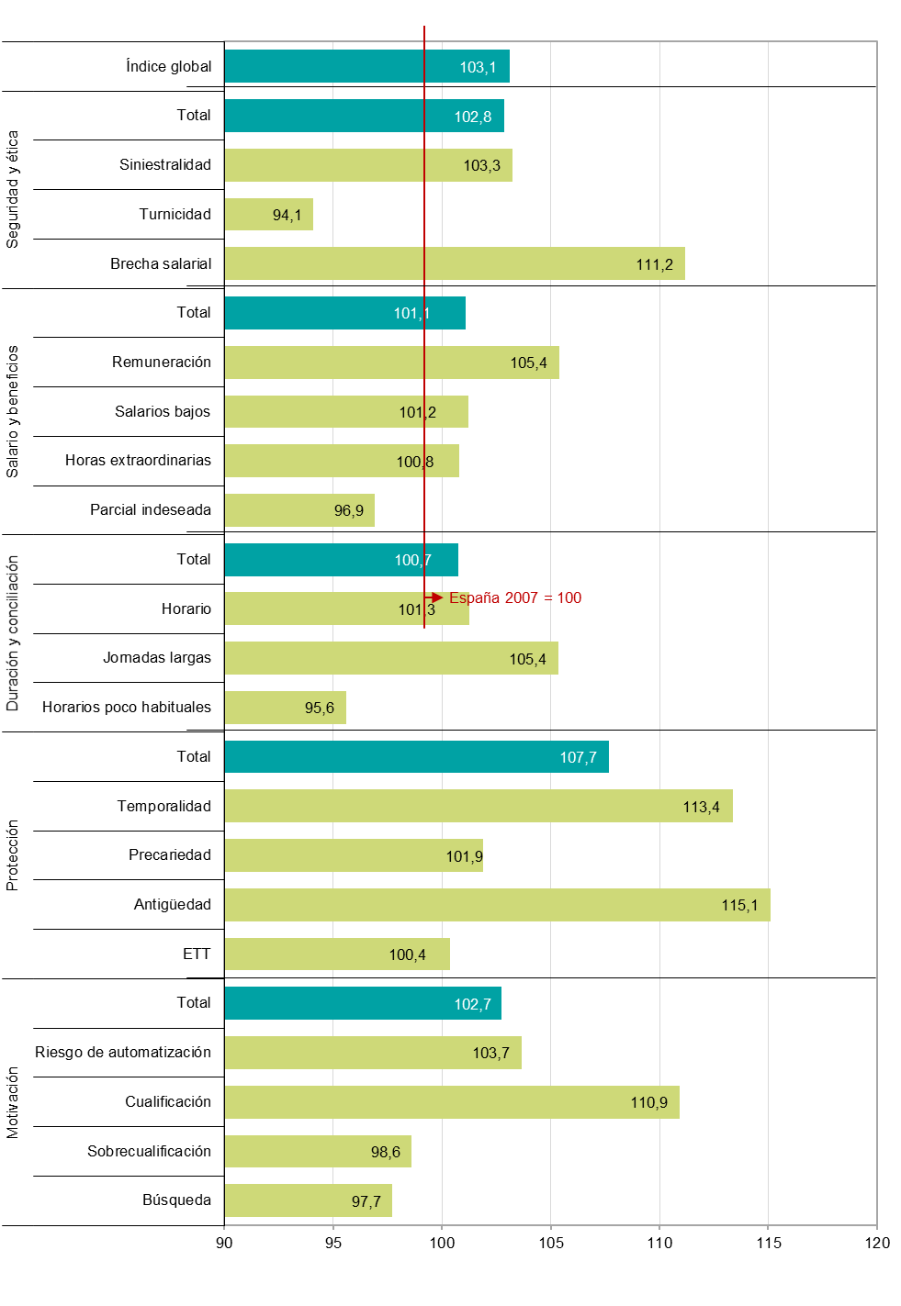Summary
Non-inclusive work environment: 7 each 10 employees work in non-inclusive to persons with disabilities.
Abstract
This work analyzes the quality of employment in Spain and its autonomous communities throughout the period 2007 - 2022 using a synthetic index that includes the behavior of 18 indicators corresponding to 5 dimensions: safety and ethics; salary and benefits; duration of work and conciliation; protection; and motivation. The results show that the index, after overcoming the impact of the Great Recession and COVID- 19 , is currently at maximum levels for the period considered, with a moderate improvement compared to 2007 of 3 . 1 points. At the territorial level, a clear pattern of persistent inequality is observed throughout the period. All regions, except Extremadura , have improved compared to the whole 2007 and the Basque Country, Madrid , Catalonia, Navarra and La Rioja show the highest levels of employment quality.
1. Introducción
The quality of employment is undoubtedly a key factor for the well-being of individuals and societies and their importance is increasingly clear to governments, civil society and the general public. In addition, the quality of employment depends on a wide range of factors. This means that beyond a certain global vision that everyone can share about its definition, its measurement is a complex task, the various aspects of employment that influence their quality or women, increasing efforts to attract them to the labour market, in all sectors and eliminate differences between men and women in Labour market.. In short, the multidimensional nature of the quality of employment hampers their measurement and data in this case, as so many others, are a basic requirement for any rigorous analysis of the phenomenon. This paper presents some results on the quality of employment and its autonomous communities based on a recent review of the case of spain (Serrano, Soler and Pascual 2023 ) from a measurement of the quality of employment in line with the criteria of the most recent analytical frameworks developed at the international level, at its multiple dimensions and to take the point of view of the worker.
The development of these analytical frameworks it has to be put in the growing importance of the issue of the quality of employment within the social debate, in a context in which the objective of full employment has become increasingly complemented with a concern for the aspects of its quality. The goal of improving in this area has become a regular feature of the agendas of governments, becoming a regular basis included as one of the basic lines of economic and social policies, geared increasingly to create quality employment for all in a work environment increasingly changing (Organization for economic cooperation and Development, oecd 2020 ).
These developments led to the recognition of the need to be able to analyse the phenomenon and that this aimed at having appropriate analytical frameworks. As a result of that international agencies have devoted considerable efforts to develop conceptual frameworks, defining appropriate systems of indicators to bring the quality of employment and, therefore, make it possible to follow their progression from source statistics available, all with a sufficient guarantees of comparability between economies.
In the specific case of Spain, developed country and a member of the european union, the most noteworthy initiatives are related to the work of oecd in the field of measuring the quality of employment and Eurostat indicators for the countries of the european union and the national statistical institute for the case of spain. These are implemented within the framework developed by the United nations economic commission for Europe with a view to the analysis of the quality of employment (UNECE 2015 ) and, ultimately, are inspired by the report's recommendations Stiglitz-Sen-Fitoussi for the measurement of social and economic progress (Stiglitz, Sen and Fitoussi 2009 ), And before turning to the consideration of the quality of employment in the spanish autonomous communities, were as follows some of its principal features.
The framework developed by oecd considers three dimensions of work affecting the welfare worker's individual and are relevant to economic policy: the salary (earnings quality); security of the labour market (labour market security); and the work environment (quality of the working environment). The OECD closer wage quality from the average wage and the unequal distribution of wages. Indicator of the security council shows the probability of losing their jobs and the cost that such an eventuality would have for the worker takes into account the expected duration of unemployment and characteristics of unemployment benefits. Finally, the indicator of the working environment captures other features of employment (nature and content of the labour relations, timetables, in the workplace, etc.). From these three indicators oecd produces an Index labour tension (job strain) that shows the percentage of workers with jobs characterized by high levels of labour demand (job demands), such as have long hours and not very flexible and substantial risk factors of physical and health, and few resources to address them (job resources). These include the degree of self-employment, training opportunities, collaboration by colleagues and supervisors or the existence of prospects for promotion.
The report Stiglitz-Sen-Fitoussi ( 2009 ), very influential in the field of measurement of social and economic progress, raises the need to go beyond variables such as per capita income, based on macromagnitudes from national accounting and gross domestic product (GDP). Instead, it suggests a multidimensional approach to quantify the progress of societies, including non-monetary variables. In particular, one of the paragraphs of the report includes issues related to the multidimensional measuring the quality of life of individuals. In this sense, it is an approach which exceeds the breadth of perspective to other relevant prior initiatives in this area, as the human development index of the un. Along the lines proposed by this report, the United nations economic commission for Europe (UNECE 2015 ) has led the development of an analytical framework for a comprehensive and objective approach to measuring the quality of employment in its many dimensions (Eurostat 2023 a).
Eurostat has adapted the UNECE framework for the particular case of european countries, including a set limited 42 indicators relevant to the case of developed economies such as Spain (Eurostat 2023 (b). It should be noted that the image of the spanish case derived from this set of indicators is generally characterized, as with the indicators of the Oecd, by a lower quality of employment than average, although with considerable heterogeneity according to the question.
Finally, in the particular case of Spain and its autonomous communities, include the development by the INE of its system of indicators of quality of life. This system is in line with the principles of the report Stiglitz-Sen-Fitoussi and Eurostat. This system of indicators of Quality of life provides information at the autonomous community and includes 60 indicators and provides for nine dimensions: 1 ) material conditions of life; 2 ) work; 3 ) health; 4 ) education; 5 ) leisure and social relations; 6 ) physical security and staff; 7 ) governance and basic rights; 8 ) environment and environment; and 9 ) general experience of life.
The labour dimension distinguishes, in turn, two subdimensiones: quantity and quality. The amount includes three typical indicators of participation in the labour market (rate of employment, considered by the INE as main indicator of quantity; rate of unemployment and long-term unemployed), as well as an indicator of underemployment (percentage of employment for involuntary part-time). The second sub-dimension, which seeks to reflect the quality of employment, includes four indicators, two of them associated with economic insecurity and the worker's mental (percentage of employees with low wages, temporality), other related to the reconciliation of work and personal life (percentage of workers with long hours) and a fourth indicator (considered by the INE, in addition, as the main indicator of quality) that reflects the view of workers with regard to the satisfaction with the work.
2. El concepto de calidad del empleo
As noted above, the quality of employment may seem in principle a clear concept. However, its definition to the operational concept in practice is more complicated and, furthermore, it is not free in some measure of value judgments. The difficulty is increased when it purports to raise a definition that makes it possible to measure the quality of employment from source statistics available at the regional level in Spain.
Firstly, both the very concept of quality of employment as the selection of the characteristics relevant to measuring the quality can depend on the point of view. For example, employers and workers can have different perspectives on the overall quality of employment or on some of its more specific areas of specific (e.g., unusual working hours, wages, possibilities for reconciliation, etc.). Similarly, the perception about what constitutes quality employment may also vary so greatly between territories and significant moments of time, according to the level of development reached or according to the economic cycle.
This has led to take into account features of employment as diverse as the wages, the type of contract and part-time schedules, exposure to occupational and health, the chances of reconciliation, the type of occupation which takes place or satisfaction experienced at work, among others. In Addition, correspondence between these characteristics of employment and preferences and characteristics of individuals has been seen as another point of the quality of employment. For this purpose have been taken into account issues such as the grounds of part-time or temporary, the degree of adjustment between requirements of the position and the formation of the worker, the satisfaction with the timetable or the desire for change jobs, indicative of dissatisfaction with the current employment, among others.
3 . The quality of employment: methodology and results
In the area of job quality Eurostat refers to the framework established by UNECE as a starting point for measuring its quality (Eurostat 2023 b). Dicho organismo ha elaborado el Handbook on Measuring Quality of Employment (UNECE 2015 ), a reference manual is to be comprehensive and includes a wide range of indicators in seven dimensions: (i) security and work Ethics, (ii) income and benefits of the use, (iii) time and work-life balance, (iv) security of employment and social protection, (v) social dialogue, (vi) development of skills and training and vii) labour relations and work motivation.
1 2
 Source: Serrano, Soler and Pascual ( 2023 ).
Source: Serrano, Soler and Pascual ( 2023 ).
The method of standardization of information has been made by index numbers 3 taking as reference the value of spain 2007 for each of the indicators of The election. 2007 it seems reasonable basis since that year was the most favourable situation of the spanish labour market of the past 40 years, just before the start of the Great Recession, following the expansions of the most extensive of the spanish economy. This method allows the comparability between regions and the analysis of the time evolution.
Therefore, it is possible to see how far the regions have improved or deteriorated in respect of themselves and also if they have converged on or disagreed with the national average. On the aggregation, has chosen an arithmetic average of all dimensions, where all indicators have the same weight (equiponderación) 4 .
 Source: Serrano, Soler and Pascual ( 2023 ).
Source: Serrano, Soler and Pascual ( 2023 ).
 Fuente: Serrano, Soler y Pascual (2023).
Fuente: Serrano, Soler y Pascual (2023).
Turning to the territorial aspect shows considerable differences in quality between the various autonomous communities (figure 2 )
 Source: Serrano, Soler and Pascual ( 2023 ).
Source: Serrano, Soler and Pascual ( 2023 ).
In general, the majority of tend to show progress in each of the five dimensions considered. These developments are particularly intense and show a more general nature on the protection dimension. On the contrary, are not strangers setbacks on the Contents of motivation and duration of work and conciliation, although it was generally concerned almost always magnitude moderate declines.
1 In general, the majority of indicators are expressed in a natural way in the negative (accidents, temporality involuntarily, wage gap, etc.), but in other cases (remuneration, seniority and qualifications) is the opposite. For more interpretability to Contents and better understand the evolution of the quality employment has been taken is to harmonise all indicators from a positive sense. 2 To assess the appropriateness in the selection of indicators has been carried out a study of correlations, in order to detect potential similarities between the different measures, and decide whether it could prove convenient to eliminate some of them in order to avoid repeating information. 3 4 The choice of method or another of aggregation (arithmetic average or geometric) does not alter significantly the Contents. Similarly, it has been established that the option to add a first phase in individual indicators in the five dimensions to add subsequently considered dimensions in the final Index nor materially change results for having taken directly add individual indicators in a single phase.
4 Conclusions.
In the case of spain and its autonomous communities, with unemployment rates are still high and over what has been in the neighbouring countries to achieve full employment must remain a central objective of the economic policy strategy. However, that goal should be combined with improved quality of employment, a matter of growing social importance whose relevance has only increase following the experience of a pandemic COVID- 19 . Of Course, the existence of employment is a necessary condition in order to begin to talk about its quality, but the idea that the quality of employment is a key element for individual well-being and social council is increasingly present, affecting as much as the decisions of governments, employers and employees.
As we have seen, the quality of employment is complex and difficult to operationalize its multidimensional nature. Employment has many facets and each influences their quality in varying degrees. When it adopts such a global perspective, the results indicate that the quality has improved moderately over the year 2007 , situation prior to the great recession and far more like full employment has been seen in spain in the past 40 years. It Also allows to see clear differences between the effects of the great recession and the COVID- 19 in terms of quality of employment. 2019 still not recovered the level of quality of employment of 2009 while 2022 it had overcome the setbacks of 2021 . This double feature improvement between, 2007 and 2022 and more prompt recovery after the COVID, introduced a general nature at the autonomous community.
Moreover, the Contents of quality draws a clear pattern of territorial disputes which, moreover, is remarkably consistent over time and consistent with the observed in other areas of social and economic development. In terms of overall quality of employment higher levels were presented in the País Vasco , Madrid , Cataluña , Navarra and La Rioja compared to a less favourable situation Canarias and the south peninsular. In particular, the analysis of the relationship between quality of employment and other socio-economic variables of interest shows that the regional employment quality show a high correspondence with other core welfare indicators and economic development, as per capita income. This feature is in contrast, for example, with what happens when you compare these variables with the main indicator of quality of work of the system of indicators of quality of life of the INE (which would make Canarias a leader in quality and País Vasco and Madrid in the group of lower quality).
There are two aspects of the end of the analysis made in the case of the autonomous communities using the index. First, a strong positive relationship with the quality of employment of the productive specialization and training for workers in the region. These factors are, therefore, as two key determinants of regional differences in quality of employment and therefore, as levers to improve in this area. Secondly, communities with a higher-quality employment are, in general, the activity and employment rates higher and, above all, unemployment rates lower. This is important because it implies that improving the quality of employment in Spain would not conflict with the need to continue reducing the rate of unemployment. In other words, creating more jobs not necessarily would have to look at the use of poor-quality jobs.
In any case, we should not forget that the quality of employment is going to depend on a complex set of factors of diverse nature on which the influence of the authorities is quite varied, as the current economic climate, the regulatory and institutional framework of the labour market, the characteristics of the productive fabric or training of workers. The situation of each community in these areas have been conditioned in the past, it conditions in the present and will continue to leverage in the future the quality of their employment.
Bibliography
EUROSTAT. Labour market. Information on data. Quality of employment. Luxemburgo: Comisión Europea. Disponible en:https :// ec.europa.eu/eurostat/web/labour-market/information-data/quality-employment[reference: december 2023 a].
Quality of employment. UNECE framework. Luxembourg: European commission. Available at:https :// ec.europa.eu/eurostat/documents/ 341520 / 8195276 /Quality + of + employment _ UNECE + Framework.pdf/b 8 ff 01 d 0 - 5 c 40 -bb 79 -f 9 to 2 -d 43 to 5 d 2 ba 1 e 6 ? t = 1673274377303 [reference: december 2023 (b].
FREY, C. B. and M. A. OSBORNE ( 2017 ). «The future of employment: how susceptible are jobs to computerization?». Technological Forecasting and Social Change 114 : 254 - 280 Available at: https :// doi.org/ 10 . 1016 /j.techfore. 2016 . 08 . 019 .
INE indicators of quality of life (BCI). Madrid Available at: [reference: december 2023 ].
OECD (organization for economic cooperation and development) ( 2020 ). How's life? 2020 : measuring well-being. Paris: OECD Publishing. Available at: https :// doi.org/ 10 . 1787 / 9870 c 393 -.
SERRANO, L. (ed.), á. SOLER and F. PASCUAL ( 2023 ). The quality of employment in spain and their communities. Madrid : Fundación Ramón Areces.
STIGLITZ, J. E., A. SEN and J. P. FITOUSSI ( 2009 ). Report by the Commission on the Measurement of Economic Performance and Social Progress. París. Disponible en: https :// ec.europa.eu/eurostat/documents/ 8131721 / 8131772 /Stiglitz-Sen-Fitoussi-Commission-report.pdf.
UNECE (united nations economic commission for Europe) ( 2015 ). Handbook on measuring quality of employment: a statistical framework. New York: Geneva: united Nations. Available at: https :// www.unece.org/statistics/publications/handbook-measuring-quality-employment.














.jpg)








